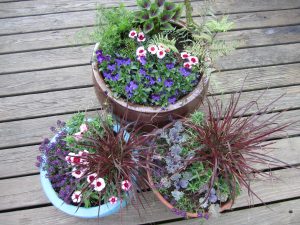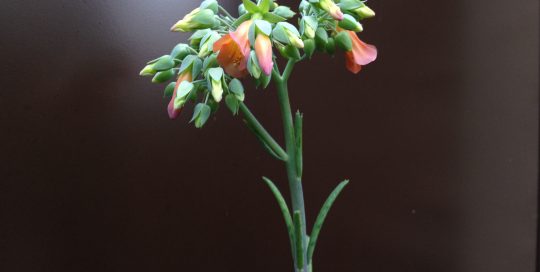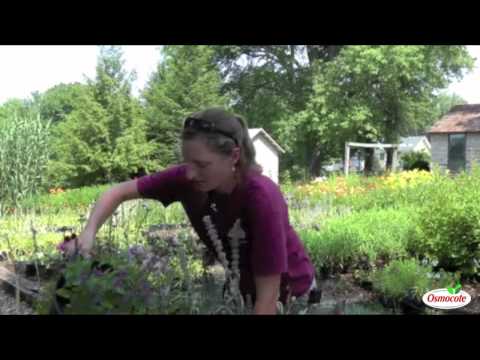Flowers for Spring Containers
Views: 6605

Spring can be a tricky time of year, especially this year. Here in Indiana, we had an extremely warm March followed by several frosts in April, and I’m still not sure if we even had winter?! Local nurseries have been selling tender annuals and tropicals for a month now, but these recent frosts have reminded me that it’s best to play it safe when planting in the spring. Choosing plants that thrive in cool temperatures can help your containers last through multiple spring frosts.
Best Plants for Spring Containers
Here’s what I came home with after a trip to a local nursery (and yes, they were out of Pansies):
- 2 Pennisetum setaceum ‘Rubrum’ (‘Fireworks’ Variegated Red Fountain Grass, quart)
- 2-4 packs of ‘Montego Pink’ Snapdragons
- 1 ‘Heartthrob’ Viola (perennial, quart)
- 2-3” Asparagus Ferns
- 2-4 packs of ‘Super Parfait Raspberry’ Dianthus
- 2-4 packs of ‘Easter Bonnet Violet’ Alyssum
- 1-4 pack of ‘Nagoya Mix’ Flowering Kale, and 2-4 packs ‘Sorbet Black Duet’ Violas
Any of these plants should be able to stand up to chilly nights. Believe it or not, the grasses and perennial viola would probably be the most susceptible to frost damage, but I couldn’t resist their colors! When shopping for container plants, compare them side by side before you buy them to see if they look nice next to one another. I’m only expecting to get a month or so out of these pots, so appearance is my primary concern. Otherwise, I would pay more attention to mature size and water needs.
Prepping Spring Pots
First, I prepped my pots. I tend to reuse my potting soil from year to year. Still, I know it’s recommended to change it in between plantings, but sometimes it just isn’t in my budget. I do try to at least throw in a few handfuls of fresh potting soil and mix it in with the old. This is also a good time to mix in a handful of compost or some slow release fertilizer.
Time to Plant
Plants often come out of their pots rootbound (especially if they’re in cell packs). Rootbound means the plant has been stuck in a container for too long and its roots, having nowhere else to go, have wound tightly around themselves. To help them out, gently tease the roots apart with your fingers before planting. Don’t worry if you break a few roots, it happens. Arrange plants from short to tall and plant as deep as the root ball. Use your hands to firm the soil around the roots and water once everything is planted. Water all outdoor containers when soil feels dry to the touch (probably multiple times a week if it doesn’t rain, containers dry out fast, especially terra cotta pots).
Each of the two smaller containers (front of picture) have one Red Fountain Grass, four Alyssum (small purple flowers), and four pink Snapdragons (mostly green in this picture). The only difference between the two is the turquoise pot has 4 Dianthus (light pink flowers with dark pink centers) and the terra cotta pot has four Kale (frilly purple foliage).
Mixed Spring Containers
I cram plants into containers for instant results. I don’t expect the Kale, Alyssum, or Snapdragons to reach their full size before I change them out with warm weather annuals, so I don’t mind limiting their space. Plus, if a plant dies, there are plenty of others to fill in around it. Both of these containers would do best in full sun to part shade and would perform well until temperatures regularly climb to eighty degrees and higher. Those are the temperatures when cool weather plants start to decline. However, because they can transition into hot weather, the Fountain Grasses are a season-long investment. I’ll just leave them in the pots when I change out the rest of the flowers with summer annuals.
The large pot (back of picture) didn’t turn out as well as I’d hoped; there are just a few too many Violas….. three less would have been better. I crammed all 8 Violas (small blue flowers), 2 Asparagus Ferns (airy green foliage), 4 Dianthus, and the perennial Viola (green edged leaves with purple centers) in this large pot. I also threw in a perennial Ghost Fern (Athyrium, silvery purple foliage) that I had sitting around.
Perennial Uses
Using perennials is a great way to fill out a container, and in the fall or when you’re just ready for a different plant, you simply transplant them into your garden. It’s like getting a two-for-one deal! The Asparagus Ferns, like the Fountain Grass, are a season-long investment that I will leave in the pot when changing out the Violas and Dianthus with summer annuals. I always curse Asparagus Ferns when I’m trying to pull them out of the pot at the end of the season (they get some serious root systems), but there is really nothing more reliable to add texture and an inexpensive trailing element. This pot would be suitable for part shade.
Well, that’s it for my spring containers, just a little something to brighten up the porch. Happy Spring!
Meet Abbi Hayes
Abbi's Recent Posts

Kalanchoe delagoensis: Mother of Millions







